Yeah, you’re all chomping at the bit to make soap, but we gotta do the boring equipment stuff first.
First, you’re making soap, not a fashion statement. You have to just hope the man of your dreams doesn’t come to the door. Tie your hair back, wear ugly clothes over your other clothes. Goggles are a good idea. Long sleeves and rubber or neoprene gloves. Shoes. You’re working with lye.
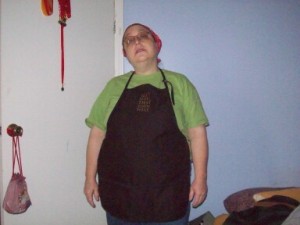
Don’t be afraid of lye. Just respect what it can do. Wear the gloves and goggles. Don’t spill it. Keep vinegar around, it counters the alkalinity of the lye. If you get some on your skin, rinse it before you use vinegar on your skin. It hurts. Don’t ask.
When you go to get lye, read the label carefully. Unless you’re ordering from a soap supplier, be sure it’s not drain cleaner, but really lye. I get lye from the hardware store, in the drain cleaner section, but lye is just lye, no aluminum stuff added to it. Read the label carefully.
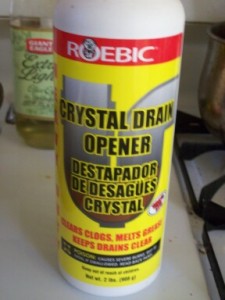
You’re looking for a chemical reaction here, remember that. Your equipment should be as inert as you can make it. Use a stainless steel pot or a glass bowl for cold process. You want enough head room in the bowl or pot so you can stir fairly violently to speed saponification. Use something that can handle heat, but not react with the lye or oils. My spoons and ladles are plastic. I mix my lye and liquid in glass, a Pyrex measuring cup.
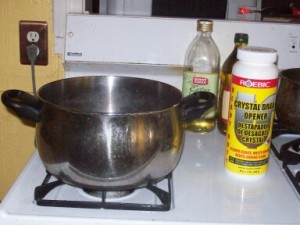
You are measuring by weight, not volume. Have a good kitchen scale, with a tare feature. Being able to zero it out is a necessary luxury. And have a good thermometer, like a candy thermometer. Needn’t be fancy, you need to measure temps before mixing with the fats and oils.
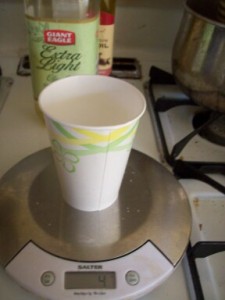
About any fat can be used, depending on what results you want. Some oils are good for lather, some for that rinse clean feel, some for conditioning. We’ll go into all that later. For now, keeping everything simple, we’re making a basic castile soap. This is the historic Castile soap, made with olive oil, lye, and water.
Olive oil was the first oil to be made into soap. It’s said it was developed at Castile castle in the 1500s, to clean the wool before it was spun.
Every oil has a SAP ( saponification) value or SAP value range, the amount of lye it takes to saponify one ounce of the fat. There’s a whole arthimetic formula, and you can go find it. Majestic Mountain Sage has a lye calculator, Soapnuts has a lye calculator. If you’re good at Excel, you can probably make one for yourself.
The Majestic Mountain Sage lye calculator gives a range for liquids. This is to make things a little flexible, especially for big orders that need to be processed and packaged as quickly as curing soap goes. There is also a chart for superfatting. When you make soap, you don’t really want all the oil to saponify. This calculator shows the lye discount for your superfat. I superfat all my skin soaps by around 8%. Much higher, the bar is soft, and the oils can go rancid faster. Much lower, and it can be drying.
One more piece of equipment: Get a stick blender. It really speeds things up. Hand stirring is good, but can take a while. Your saponifying to trace will got much faster using a stick blender or a hand mixer. But use the spoon to stir that down. You can get a false trace from using these appliances that will stir down with the spoon. When checking for trace, end with the spoon.
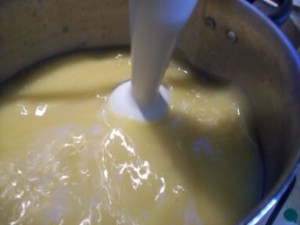
What we’re going to do here, this being a simple formula, is take the soap to a light trace. As you stir or whip your soap, it will get creamier and thicker.When you can make markings on the surface of the soap and they stay for a bit in bas relief, add the fragrance, if any, and your soap will be ready for the mold.
Fragrance oils and essential oils can be used. In a two pound batch, which this is, I use 1/8 cup of scent. This comes out to a tablespoon per pound of oil. Fragrances are available at health food and bath stores.
Now, molds. Cold process doesn’t do that well in individual molds. Keep those for melt and pour, which I see as just plain fun. The mold for cold process can be a shoebox, or, really, about anything. I have wooden box molds, which I line with a plastic grocery bag, print side down. Your mold is ready.
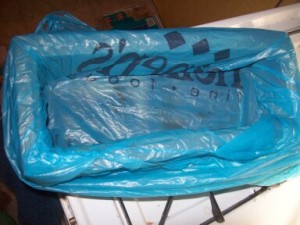
So, with all this in mind, we’re going to make a two pound batch of Castile soap.
32 oz olive oil
8-12 oz water
3.99 oz sodium hydroxide.
This will give us a fairly hard bar that produces a stable, if unimpressive, lather. Made with only olive oil, this is good for dry or sensitive skin.
Put on your soapmaking regalia: Shoes (not sandals, shoes. Respect lye), apron or ratty shirt over other clothes. Long sleeves are preferable, rubber or neoprene gloves, goggles. Tie your hair back.
Measure your lye in a container on a kitchen scale. I use a paper cup, zero the scale out, then pour the lye into it slowly. My scale doesn’t do 3.99 oz, so I measured out 4 oz. Set that aside.
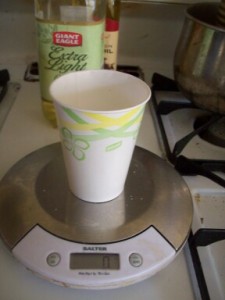
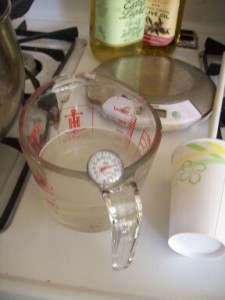
I use a Pyrex measuring cup to measure out the water. Water was the standard, so 12 oz of water will weigh out to 12 oz. The water you use should be filtered at least, distilled at best. Tap water has too much stuff in it to use and get even results. Rainwater makes a good soap, too. Put it through a coffee filter.
This is important: Snow falls on the lake. That means add your lye to the water, not the other way around. The word ‘volcano’ describes what happens if you add water to lye. I was real glad I was mixing it outside when I found that out. Which brings me to ventilation. Mix the lye and water outside or near on open window.
What happens next is the lye will cloud the water, some nasty steam will rise out of the cup, and the container will get hot. It’s called an exothermic reaction. If you put the thermometer in the cup, it can go as high as 160 degrees.
Leave your lye mix outside or move it to the fridge when the water clears. It will be hot, and takes its time cooling. Cool this to about 90°. Heat the oil to slightly warmer, then add your lye mix to the oil. Take your plastic spoon, and start to stir. Stir for about the first 5 minutes.
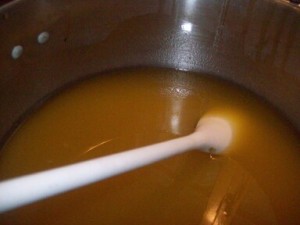
Use your stick blender or hand mixer for a few seconds, I do it to a count of 15. That’s pretty random, but you really don’t want to use it too much, or the bubbles it makes will give an uneven texture to the soap. Then stir down. I alternate the spoon with the blender. Put on my music, stir a bit, zap with the blender, stir until the next song, for the first 20 minutes. It will likely come to trace by then. If it doesn’t, you can walk away for a few minutes, then go back and stir again. Sometimes a stubborn batch will saponify to trace when you stay away for a few minutes.
When your soap is about the consistency of cake batter, check for trace. Take a spoonful of the batch and drizzle it over the top. If your drizzle stays raised from the surface for a few seconds, your soap is ready for fragrance and getting turned into the mold.
Add your fragrance, I gave my guidelines, find your own. Understand in cold process, the scent will change a bit and react with the lye and oils. For instance, it may fade as the soap cures. Not to worry, those usually come back. Some speed up trace, which is why your already prepared your mold, right? Some fragrance oils, vanilla in particular, will change the color of the soap. The vanilla fragrance oil I use turns the soap a caramel color. I’ve had some vanilla scents that turn it a deep, chocolaty color. You can get a stabilizer, but I think it just lends character.
Add your fragrance, stir well, then pour the soap into the prepared mold.
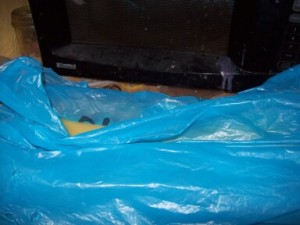
There is a little controversy about scraping the pot. I’ve heard you shouldn’t because the stuff on the sides isn’t mixed in enough. For myself, I see at least another bar of soap there, and I scrape the pot. It’s your decision.
You’ve got your soap in the mold. If trace has speeded up and it’s really thick, like pudding or mashed potatoes, smooth the top. I put the grocery bag over the top because I have cat hair everywhere. Then put your mold and its contents somewhere, and leave it alone.
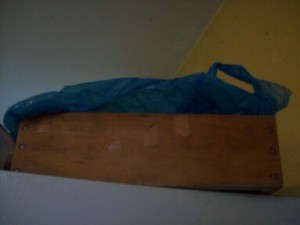
In the mold, the soap will heat up, and go through a gel phase. That’s what it looks like. The soap gets hot sometimes, especially milk soaps. Then it will cool and harden. Wait about 24 hours before you take it out of the mold. Even then, check it will hold its shape. That’s not a problem with this recipe, but there are those that take a bit longer. I had a batch with castor oil that took about a month to come out of the mold. Now I just hot process anything with castor oil in it. We’ll get to oils and their properties in probably the next post.
Your batch is hard. Grab the bag by the top and pull the soap out of the mold. Set it on a table, and carefully unwrap the plastic. Sometimes the soap needs to harden a bit more once the plastic is off. It’ll be doughy. Just keep it on the plastic and move it back to where you left it alone last night, and leave it alone again.
I use a miter box and a big knife I picked up at some garage sale or another to cut my soap. I scratched a line in it to measure my soap bars about 1 inch thick. I just slice it with the knife, and put it on racks.
Creative cubes make great soap drying racks. I have the grids all over the house, with soap curing on them.I cover my bars with a light sheet or muslin to keep bugs and dust off.
What happens here is the soap “gets used to being soap,” in that it dries a bit, saponification still continues, it becomes milder. This is the time when your scent may fade. As I said, they usually come back.
To test if your soap is shower- or bath-ready, wash your hands with a bar, wait a bit, then pay attention to the backs of your hands. If they dry out after washing with that soap, the skin feels tight, it needs to sit a bit more. The bad part of this is it may have to sit as long as 6 weeks, depending on heat and humidity. Obviously, it will cure a little faster in lower humidity. Heat just helps because the soap doesn’t have to deal with temperature, and can just cure.
When your soap is ready, it won’t be like the store bought stuff. The glycerin is still in it, there are no detergents. There are no stabilizer, either, so let it dry between uses. Get a good soap dish. The soap you’re washing with has what you put into it. And costs a lot less than that stuff at the store, too.

Leave a comment